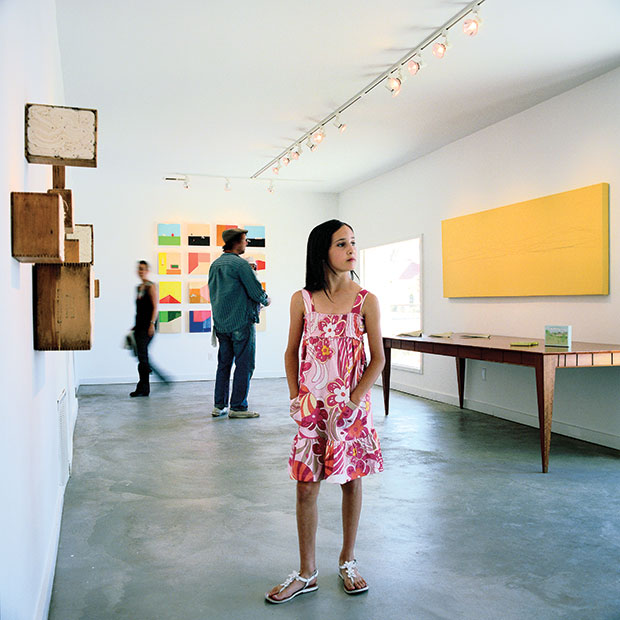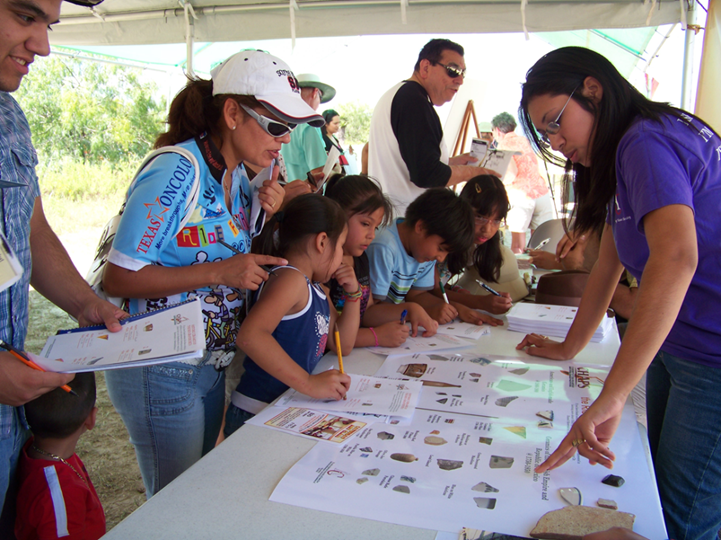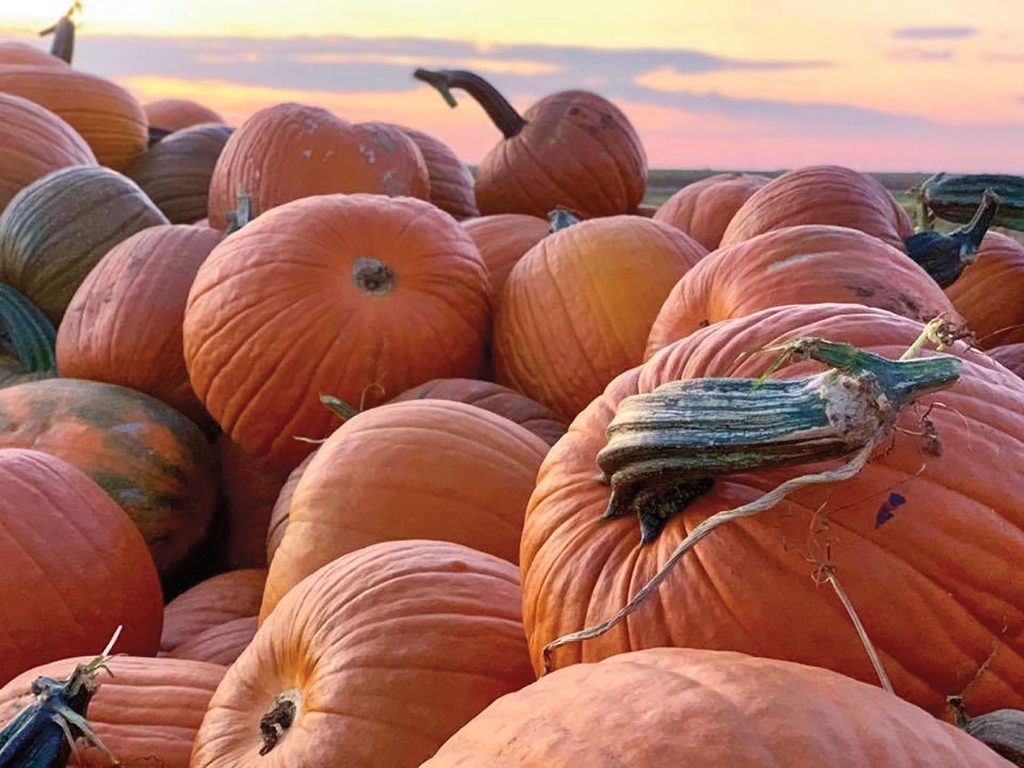
No stranger to the Marfa art world, Camille Willaford surveys her parents’ gallery, Galleri Urbane. On display (from left): works by Kate Carr, Gail Perter Borden, and co-owner Jason Willaford.
Mention the far-flung West Texas town of Marfa and most folks reference the mysterious lights that sometimes dance not far outside the city limits. But the Marfa lights that have me returning time and again are the sweeping shafts of sunlight that transform almost everything into something grander, more significant. It’s that hero light that brings me back to the windswept, high-desert landscape made famous in the film classic Giant.
It’s the light that draws artists, too; and where there are artists, there are galleries. Beyond the late Donald Judd’s world-famous Chinati Foundation, Marfa (population 2,424) now has more galleries than convenience stores, each with its own vision and artistic wattage. Passing through not long ago with my 10-year-old son, Elliott, I decided to stop into a few. Children and galleries are not an easy mix, but, like learning to swim, art appreciation is a gradual process; opening a young person’s eyes to art creates a survival skill of a different sort.
Checking into the swell digs of the lovingly renovated Hotel Paisano, I knew it wouldn’t be easy to wrest Elliott’s attention from the swimming pool or even the antique fortune-telling scale in the lobby. On the drive, the rumpy javelina and diving hawks we glimpsed had drawn his full attention, but I wonder how he’ll react when the viewing is more static. The Paisano’s dark rafters and cool Mexican tile beg a siesta, but the hotel’s shops offer baby steps into gallery hopping. T-shirts and books segue into art any kid could love—a wall of tableaus by Carlos Moseley, a Hill Country artist inspired by river rocks, flint, fossils, and driftwood. Moseley never works or shapes the stones that he arranges into miniscule scenes, a philosophy Elliott seconds: “Shaping them would take the art out of it,” he says. Asked to find a favorite, he chooses “Bow-legged Bill,” a tiny, stone composition of a mustachioed cowpoke. When he begins asking prices, I know he’s hooked.
Still, I wonder if galleries with sparse furniture and many walls will intimidate him. Steps away, Greasewood Gallery’s more traditional space—a canted sea of Mexican tile floors—summons. Today, the gallery’s silvered beams float above the canvases of David Loren Bass, who renders local landmarks in highly textured paint as prickly and craggy as the featured landscapes. Elliott is drawn to the bright palette of a splendid salute to the hoodoo (the vertical pikes of basalt that are a signature of the Davis Mountains). When he tells me that the painter’s technique has “a sort of Van Gogh punchiness,” I think we’re on the right track.
The success of this art lesson may, however, prove expensive. Across the hall at a shop chockablock with art books and supplies, Elliott announces that he needs to “stock up,” as he is now inspired to begin sketching. It is an argument I buy into—literally.
In an earlier debate, we’d agreed to toggle gallery visits with other diversions. This means the next stop is Moonlight Gemstones, a rock shop equal to any gallery. The bonus: Craftsman-cum-magician Ben Toro will design a pendant from a stone purchased here or one turned out of your pocket. Local ranchers are known to bring in whatever they’ve recently dug up, and Ben or his stepfather—rock hound and silver artisan Paul Graybeal, who opened the store 12 years ago—take it from there. Their works range from agate bookends to silver motorcycle mounts for a bull’s horns. “We like the challenge of making things we haven’t tried to make before,” says Toro.
The next morning we start with what I think of as the most child-friendly sort of art—folk art and “outsider” works—at Yard Dog, the new, Marfa branch of the popular Austin gallery. Manager Rachel Manera welcomes us into the former gas station with its wonderfully seasoned, salmon-red and ochre cement floors. The drenching light suits the gallery’s diverse collection of contemporary works, including paintings by noted folk artist Jimmy Lee Sudduth, who literally sold his art outside initially, under trees or curbside, and always worked outside traditional boundaries.
I thought the idea of art executed with mud mixed with Pepsi or viewed with 3-D glasses would be a draw, but Elliott was not impressed by the more whimsical pieces at Yard Dog, and the extreme visions of some artists—raw, intriguing, and compelling to me—had him bolting for the exit. His strong reaction, I explain to him, means the art has touched him—and not all such touches are gentle.
What to do with an unhappy child? Feed him at the Food Shark. Parked (usually) near the shaded, Donald Judd-designed picnic tables across from the Marfa Book Co. (the town’s communal heart), the shiny food wagon serves up the best falafel you’re likely to find west of the Pecos. The giant chocolate chip cookies soon have Elliott grinning again. We escape the wind and munch away inside the bookstore, and then peruse the art books.
Entering the bookstore’s backroom gallery feels like falling into a pool of light—the space is flooded from skylights and a high circuit of windows. The room is like a basketball court bracketed in art instead of bleachers. In a gentle stroll past Mary Bonkemeyer’s abstracts, Elliott challenges himself to identify paintings as I read the names. Teals and royal blues are a giveaway for Tadpole Pond. Yellow Wind is aswirl with paint. In Ripe Grapes, purple ovoids line up for a family portrait.
The evening viewing is, of course, the Marfa Lights, but on the way to the observation platform, we stop at the Luz de Estrella Winery. Opened in July 2006 by John and Linda Armstrong, the winery offers daily tastings and Friday-night light-viewing parties. Winemaker Patrick Johnson’s award-winning chenin blanc graces the house list, but a bottle of blanco, with its blissful kiss of honeysuckle, also pleases. The robust Big Bend Red begs to be packed into a picnic. While adults sip and yak with the bartender, kids play outside with a pair of lively Boston terriers.
Lights successfully sighted (and veracity duly discussed to no conclusion), we round out our day with dinner at Maiya’s, a cavernous, red, black, and white space filled with a cool Greenwich Village vibe, beautiful people at the bar, and a gaggle of giggling children still dusty from a day in Big Bend. The homemade pistachio ice cream is to scream for, and paper tablecloths allow Elliott a fevered round of artful expression.
The next day dawns bright. Over breakfast at The Brown Recluse (for sale at press time), Elliott says he has come to the conclusion that “art can be anything that makes you think in a new way.” With this insight, we untangle the tumbleweeds at the screen door and set out to our next stop following directions that are classic Marfa: Head two blocks south of the flashing stop light.
Outside a 100-year-old, pale-gray adobe house, reborn in a sea of blonde grass as the exhibitions2d gallery, a sign gives me pause: Please Supervise Children Responsibly. Perhaps we best keep moving, I think. But while we gawk at what we can safely see through the windows, gallery owner and self-described Floor Scrubber and Director of Spackling Dennis Dickinson arrives and ushers us in with a beaming smile. A step inside, Elliott is gulping great breaths of air, the better to exclaim over Susan York’s wall-mounted solid-graphite geometric shapes. When Dickinson stops to hear Elliott explain how the interplay of shadows and light double the artwork’s impressions on the viewer, I happily take full responsibility for him.
Dickinson gives insider information on his coast-to-coast stable of artists as if he’s passing along family news. Elliott is drawn to the work of John Robert Craft, a third-generation Clarendon rancher- artist. Craft creates cast-iron objects of weighty interest such as the 84-pound, evenly ridged sphere that Elliott is itching to take home. The sculpture is intriguing enough, but that Craft rolled it over a 96 x 56-inch sheet of Plexiglas covered with printer’s ink and newsprint to make yet another work of art wins my son’s heart. This is a gallery to excite a boy (and his mom) with its surprises and stories—one of the exhibitors here, acrobat Ken Morgan, ran away from the circus to become an artist. And in what big-city gallery do open windows allow a breeze that is as fresh as the viewing? Elliott’s review: “It’s all really fun.”
Pulling up at Galleri Urbane, we’re greeted by an anamorphic figure visible through a window of bumpy glass. The entrance of the low-slung adobe is graced with a bright-green sign and a pair of agaves—a juxtaposition of the artful and natural that says everything about Marfa’s art-world appeal. Inside the horseshoe-shaped gallery, co-owner Ree Willaford has just finished hanging Andrea Zuill’s Concept of Identity show, a series of Jordan Almonds-hued oils of rumpled humans—from a busty, bunny-eared blonde to a child sporting antlers. The squatty faces and off-kilter icons like birthday cakes and crowns have a double-edged appeal—at once winning and sinister.
Chatting with Ree and her husband, artist Jason Willaford, we learn that the high-desert light drew them from San Diego. Well, not just the light; equal in appeal, says Ree, was the fact that Marfa is “a small town where you can get an espresso or a martini.” She hangs art with a sensibility to visual merchandising that—along with her own hypnotic energy—reels me gently into the exhibit space.
In a workshop at the back of the gallery, Jason mixes beeswax, copal, and carnauba wax for his encaustic paintings. The process results in a hot liquid the consistency of maple syrup that can be layered onto a canvas and reheated to fuse into an enamel-like finish. Scraping minimalist incisions into that finish is a reductive process that Jason finds addictive. “It’s harder to paint nothing than something,” he says.
Elliott overhears us chatting about the Willafords’ 12-year-old daughter, Camille, and wonders if she is around. She’s in school, but Jason invites Elliott outside to view the backyard—it’s a menagerie of ducks, dogs, cats, fish, and hatching chicks that proves more interesting than a mere girl. It also gives a new definition to kid-friendly galleries.
That night at the Pizza Foundation (where the pizza is truly artful), Elliott says exhibitions2d has given him a true taste for art, but Galleri Urbane has shown him how art and real life can happily merge.
It was, he says, a perfect day.
MY FAVORITE MARFA
Marfa is 190 miles southeast of El Paso and 425 miles west of Austin, at the intersection of US 90, US 67, and Texas 17. Contact information for lodging, restaurants, and other attractions mentioned in the story follows. For more information, call the Marfa Chamber of Commerce at 432/729-4942 or 800/650-9696; www.marfacc.com.
The Brown Recluse (for sale at press time), 432/729-1811; www.brownreclusemarfa.com.
Food Shark, 432/386-6757; www.foodshark marfa.com.
Hotel Paisano, 432/729-3669 or 866/729-3669 (reservations); www.hotelpaisano.com.
Luz de Estrella Winery (3.8 miles east of town, on US 90), 432/729-3434 ; www.luzdeestrella.com. The winery will arrange Marfa Lights-viewing parties if given 24 hours advance notice. Maiya’s, 432/729-4410; www.maiyasrestaurant.com. Reservations recommended.
Marfa Lights Viewing Station, 8 miles east of town, on US 90. Open-air viewing station is open 24/7. Moonlight Gemstone, 432/729-4526 ; www.moonlightgemstones.com.
Pizza Foundation, 432/729-3377; www.pizzafoundation.com.








